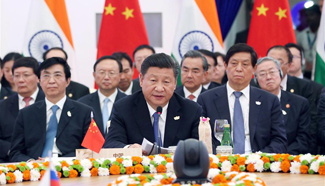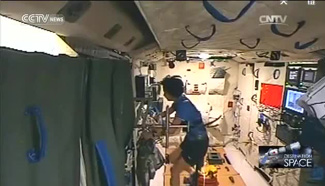Poverty alleviation through medical security has been implemented. The Chinese government continues to strengthen its poverty alleviation effort through promoting medical security, reducing the medical costs of the impoverished population in rural areas, strengthening medical and health services in poverty-stricken areas, and improving the health of people in these areas, so that they are not reduced to or returned to poverty because of illness. All this has ensured the right to health. Improvement has been made in the New Rural Cooperative Medical System (NRCMS), which covers over 97 percent of rural residents. In 2016, the NRCMS offers a per capita subsidy of RMB420, and reimbursement ratios of outpatient and inpatient costs reached 50 percent and 75 percent. Serious illness insurance for urban and rural residents has been fully implemented, covering more than one billion residents with a reimbursement ratio of no lower than 50 percent. A medical emergency relief system has been established to help people suffering from serious illnesses, and universal medical care has been further improved to cover major illnesses, significantly reducing the medical costs of rural residents. Since 2012, the central government has allocated RMB79.4 billion to support infrastructure construction at 110,000 health service units in poverty-stricken areas. Programs have been carried out to offer free medical education to rural students who will return to serve in their areas, to send general practitioners to clinics in rural areas, to pair up hospitals in urban and rural areas to enable medical assistance, and to organize state-level hospitals to help and support county-level hospitals in poverty-stricken areas. In 2015, 45 items in the 12 categories of basic public health services were implemented, with per capita subsidy rising from RMB15 in 2011 to RMB40. Programs have been carried out to ensure that women in rural areas have access to folic acid supplements in order to prevent neural tube defects, and to improve child nutrition in poverty-stricken areas, in an effort to strengthen disease prevention and control and promote good health. Thanks to these efforts the health of the impoverished population has gradually improved. In 2016, the National Health and Family Planning Commission, the State Council Leading Group of Poverty Alleviation and Development, and 13 other departments jointly launched a poverty alleviation project through health promotion, so as to ensure that the impoverished rural population will welcome the arrival of a moderately prosperous society with the rest of the nation.
Chart: NRCMS per capita subsidy
Programs are being implemented to lift all rural residents out of poverty. The state has released a plan to align the subsistence allowances system with development-oriented poverty alleviation policies in rural areas. Focusing on the goals of poverty eradication, all localities are improving their policies, measures, and working mechanisms to offer subsistence allowances to the most impoverished rural residents, striving to increase the standards of social security for the impoverished population. Registered rural families eligible for subsistence allowances are included in the subsistence allowance system in accordance with established procedures, and they receive the allowances based on the gap between their per capita household income and local subsistence allowance standards. Rural families covered by the subsistence allowances and eligible for poverty reduction programs are registered in accordance with established procedures, and receive help and support based on the different causes of their poverty. Families which were lifted out of poverty but have returned to poverty are included in temporary relief, medical relief, rural subsistence allowances and other social relief systems, and are registered for help and support. In 2015, the number of recipients of rural subsistence allowances was 49.04 million, with the standard raised from RMB143 per person per month in 2011 to RMB265. Per capita expenditure on supporting rural population in dire poverty in nursing homes and at their own homes reached RMB6,026 and RMB4,490, growing by 48.4 percent and 49.3 percent compared with the 2012 levels.
Experiments have been carried out on poverty alleviation through asset investments. In recent years, to help impoverished people experiencing difficulties in achieving self-development, some localities are actively experimenting on poverty alleviation through asset investments. With poverty reduction as the ultimate goal, poverty alleviation funds and other funds for rural areas are invested in infrastructure construction and industrial development in poverty-stricken areas, and the assets are quantified as shares owned by the households with a partial or permanent inability to increase their property income. The investment is mainly made by promising industries with local characteristics, and the farmers' specialized cooperatives often play an active role in running the operations, to ensure that impoverished people enjoy a guaranteed return and dividends on such asset investments, and that they may also benefit from transferring their farmlands and working in local businesses. At the end of 2014, the state initiated trial runs of poverty alleviation projects through developing the photovoltaic industry in provinces of Anhui, Hebei, Shanxi, Gansu, Qinghai, and Ningxia Hui Autonomous Region, pumping new blood into these regions by increasing their asset income. In 2016, the state has strengthened the initiative, planning to increase the average household income of two million households registered with incapacity (including disabled persons) to RMB3,000 and above by 2020. This will involve 35,000 registered villages in 471 counties of 16 provinces and autonomous regions.
Services have been strengthened to support employment and entrepreneurship. In recent years, the government has given top priority to employment, enacting more active employment policies, providing vocational training, and strengthening services to support employment and entrepreneurship, effectively ensuring impoverished people's right to work. It has launched the Spring Tide Action, a program to enhance the occupational skills of migrant workers, providing impoverished rural laborers with training programs in employment and occupational skills, and starting businesses, with subsidies provided for attending these trainings. The state has implemented the Opinions on Strengthening the Dewdrop Project to Support New Laborers from Impoverished Rural Families to Receive Vocational Training, providing an annual subsidy to registered impoverished families with people receiving vocational education. China has further improved its public services for employment. It has strengthened the platform for labor and employment and social security services at the grassroots level, organized the Spring Breeze Action and other employment services, strengthened the alignment of labor exports and imports, and offered free services to the impoverished rural population in guiding their employment choices, introducing jobs and opportunities, and offering counseling on the policies, laws, and regulations regarding employment. The state has helped surplus rural laborers to seek employment in cities and promoted their steady transfer, with 7.93 million new migrant workers added on a yearly basis in 2011- 2014. China has actively implemented policies to support entrepreneurship, organizing training sessions for people who are interested in starting businesses and who need training in entrepreneurship and relevant services. Other services such as information, guidance on business operations, new business incubation, and follow-up services are also provided to support new entrepreneurs. (more)










